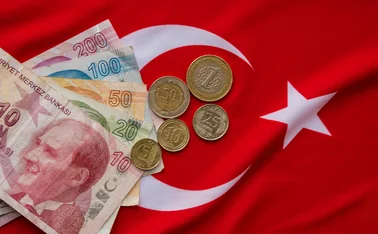
The renminbi and the international monetary system
The role of RMB post-SDR inclusion

On October 1, 2016, the International Monetary Fund (IMF) will make the renminbi the fifth currency in its Special Drawing Rights (SDR) basket. It will have the third largest weighting, behind the US dollar and euro, ahead of the Japanese yen and British pound. Since the pilot projects of cross-border renminbi business were launched in 2009, the internationalisation of the renminbi has achieved notable successes. The RMB's inclusion into the SDR basket, announced in late 2015, indicates one of the most influential international organisations recognises the reform and opening of China's financial sector.
New opportunities are often associated with new risks. The increasing volatility of the renminbi exchange rate in the past year has helped people to recognise this reality. Nonetheless, the internationalisation of the renminbi continues. By the end of 2015, the People's Bank of China (PBoC) had signed swap agreements with 33 foreign central banks and monetary authorities, with a total amount of 3.3 trillion yuan, and established RMB clearing arrangements in 20 countries and regions. As reform efforts continue, the implementation of the Belt and Road initiative and other national strategies will stimulate more market demand. The convertibility of the RMB capital account will be orderly promoted and the scope and scale of the international use of the RMB will be steadily expanded.
New epoch for the renminbi
Due to its controversial distribution mechanism and limited scale of use, the SDR has played a limited role in the international currency reserves system. Nonetheless, the decision to include the renminbi in the SDR basket represents the most significant progress the IMF has made with reform of the international monetary system in recent years. It serves as a solid foundation for the organisation's attempt to diversify its reserve currencies, win the support of emerging economies such as China, further expand the use and volume of the SDR, and boost the influence of the SDR in the international monetary system (see Figure 1).
 Inclusion helps pave the way for the renminbi to become an investment and reserve currency, in addition to being an increasingly popular trade currency. As it progresses along this path, the RMB's international use will likely expand in both breadth and depth.
Inclusion helps pave the way for the renminbi to become an investment and reserve currency, in addition to being an increasingly popular trade currency. As it progresses along this path, the RMB's international use will likely expand in both breadth and depth.
Based on the volume of the British pound and the Japanese yen, which have a similar weighting to the RMB in the SDR basket, the volume of the RMB held as official foreign exchange reserve assets could be expected to increase by $149.3 billion to 190.4 billion in the longer term. The volume of international bonds and notes denominated in the RMB is also expected to increase – potentially by much larger amounts in a range from $303.8 billion to 1,889.5 billion.
There is also likely to be more RMB product innovation and broader RMB investment channels. Rapid growth with increasingly diversified investment vehicles could prompt a large amount of surplus capital to flow into China's interbank bond market and the renminbi's inclusion into the SDR basket will significantly boost its acceptance in the mortgage market and help RMB funds to take root in the offshore markets. Various international stock exchanges and financial institutions may accelerate their offerings of offshore securities and derivatives denominated in renminbi, while the offshore renminbi bond market may also take off.
Moreover, as the Belt and Road initiative will further strengthen the economic ties between China and the countries along the routes, the renminbi will become more influential in local markets and is likely to gradually become a settlement currency for trade and investment among non-Chinese residents in the region. This would lay a solid foundation for the multilateral use of the renminbi in the future.
Exchange rate formation is maturing
To enhance the marketisation level of the midpoint exchange rate of the RMB to the US dollar and strengthen its role as a benchmark rate, the PBoC decided to further improve the midpoint rate determination mechanism, which takes as main references the closing rate of the interbank exchange market of the previous day, the demand and supply of the foreign exchange market as well as the exchange rates of the world's major currencies. Starting from August 2015, market makers will report this midpoint rate to the China Foreign Exchange Trade System.
After the implementation of this reform, the foreign exchange reserve market experienced great volatility. The PBoC responded by strengthening communication, trying to manage expectations, providing liquidity, adopting macro-prudential measures, discouraging speculative trades, and attempting to prevent procyclical behaviours and ‘herding' effects.
 Zhou Yueqiu
Zhou Yueqiu
Since the People's Bank of China implemented the reform of the midpoint exchange rate on August 11, 2015, expectations for a depreciation of the RMB abruptly picked up. Consequently, the RMB midpoint exchange rate and the spot rate decreased by 4.4% and 3% respectively. Soon afterwards, the authorities intervened in the market and narrowed the depreciation range of the renminbi to some extent. The major measures included moderately interfering in the foreign exchange market; increasing the liquidity of foreign currency in the market; including foreign currency liquidity and cross-border cash flows in the scope of macro-prudential management and adopting macro-prudential regulatory measurements into the future foreign exchange settlement of banks; and guiding market expectation through enhanced communication.
Since the beginning of 2016, the renminbi midpoint rate and spot rate against the US dollar have been divergent in their variation trend. On January 6, the offshore renminbi traded in Hong Kong (CNH) closed at 6.6959, marking a record low after the ‘8.11' exchange rate reform. In the following month, the spread between the spot rate and the midpoint consistently was more than 100 basis points, reflecting that the People's Bank of China was guiding the trend of the exchange rate via the midpoint exchange rate again. This initiative was in the background of a weak US dollar against other major currencies. From January 5 to February 5, the US dollar index has declined by 2.4%. After lowering the midpoint exchange rate with reference to the trend of a basket of currencies, the offshore renminbi quickly went up and the spread between the spot rate and the midpoint exchange rate was also significantly narrowed accordingly.
Overall, the renminbi remained generally stable against a basket of currencies during 2015. The real effective exchange rate increased by 2.73 points, to 130.31; only half the growth of 2014. Based on the Bank for International Settlements currency basket, the RMB exchange rate index was 101.71, a 1.71% appreciation compared with the end of 2014.
It depreciated more sharply against the US dollar, drawing media attention and market participants to question the future of the renminbi exchange rate. There is, however, fundamental evidence to suggest it will remain largely stable moving forwards (see Figure 2).
 First, China's economy is generally developing steadily at medium-high speed. It is being increasingly reformed and liberalised. Second, China's productivity is growing faster than that of other major economies, which provides strong support for exports and should enable it to maintain a trade surplus. Third, the external environment has calmed, after markets were spooked by the US Federal Reserve's raising of its interest rates. Finally, the economic fundamentals will continue to provide long-term support to the RMB exchange rate.
First, China's economy is generally developing steadily at medium-high speed. It is being increasingly reformed and liberalised. Second, China's productivity is growing faster than that of other major economies, which provides strong support for exports and should enable it to maintain a trade surplus. Third, the external environment has calmed, after markets were spooked by the US Federal Reserve's raising of its interest rates. Finally, the economic fundamentals will continue to provide long-term support to the RMB exchange rate.
Although the US dollar serves as an important reference in measuring the exchange rate of any currency, it is not the only standard. Pegging the RMB to the US dollar to maintain a stable exchange rate may accumulate distortions and imbalances, exacerbate the imbalance of international payments, cause more arbitrage activities and reduce the economy's flexibility in dealing with external impacts. It is understood the RMB exchange rate formation mechanism will, in future, focus more on a basket of currencies as a major reference.
The RMB exchange rate index of CFETS has been released with reference to the 13 kinds of forex currencies listed on the CFETS. And the weightings of these 13 currencies were calculated according to their respective weighting of trade with China. Thus currencies with the top four weightings were the US dollar, euro, yen and Hong Kong dollar, and their weightings were 26.4%, 21.39%, 14.68% and 6.55% respectively. The sample monetary price was in reference to the midpoint and trading price of the renminbi exchange rate on that day. The index is anchored to prices on December 31, 2014, which are represented by a value of 100. The renminbi exchange rate index released by the CFETS provided a quantitative indicator for observing the trend of the renminbi exchange rate, which can comprehensively and accurately reflect the market changes. Moreover, this index can guide the market to divert the focus on the bilateral exchange rate against the US dollar in the past to a new frame of reference pegged to a basket of currencies. All these were instrumental for stabilising the RMB exchange rate at equilibrium within a reasonable range.
Capital account opening and offshore developments
Last year, Yi Gang, deputy governor of the PBoC and then director of the State Administration of Foreign Exchange, stressed: "China has its own schedule of achieving the convertibility of the RMB capital account and neither volatility nor external situations will disrupt the plans." As such, he said, the authorities would "steadily and orderly achieve our targets according to our own schedule".
Indeed, the Chinese government has adopted a series of measures with a view to opening the capital account during the past year. Those measures aim at facilitating investments both at home and abroad. They address elements including the operation and management of the foreign-exchange funds of multinational companies, personal foreign exchange management, foreign cash management of domestic institutions, management of cross-border fund sales in mainland China and Hong Kong, specific types of futures trading within Chinese borders by foreign traders and brokerage institutions, online personal currency exchange service by licensed institutions, and foreign exchange account management by foreign central banks investing in China's interbank markets.
According to the IMF's classification of the capital and financial account, 37 out of 40 items in China have become convertible to various degrees. The three missing items involve elements of the domestic primary capital market, such as money market instruments, derivatives and stock issuance by non-residents within China. One of the most recent announcements on capital controls, in February, saw the State Administration of Foreign Exchange set out relaxed qualified foreign institutional investor quotas, which will further open up China's domestic capital markets.
As the capital account opens, Chinese authorities are stepping up their regulation of cross-border flows. From January 1, a 100,000 yuan limit was placed on the amount of cash that can be withdrawn overseas using renminbi UnionPay cards. This measure will effectively reduce large withdrawals from banks overseas and inhibit the illegal transfer of assets. China has also tightened the authenticity verification for the purchasing and payment of foreign exchange, in an effort to curb abnormal flows of foreign exchange capital. The authorities have also launched special regulatory programmes on key sectors and channels, including special investigation programmes on exporting companies that avoid receiving foreign exchange in exporting businesses, and also on foreign cash held by individuals.
The RMB has become the second most-used currency in trade finance, the fourth most-used currency for global payments, and the sixth most-used currency in foreign exchange trade. Offshore renminbi transactions have experienced explosive growth and, according to the RMB Internationalization Report, published by the PBoC in June 2015, the daily trading volume of RMB foreign exchange in major offshore markets such as Hong Kong, Singapore and London exceeded $230 billion in 2014 (the latest data available) – more than four times the daily trading volume of domestic markets.
 Share of international payments
Share of international payments
The offshore RMB foreign exchange futures market has been developing rapidly in recent years, with daily trading volume of about $830 million. And the participants in the RMB offshore markets are more diversified, including financial institutions, enterprises and individuals, which has provided liquidity for the market. The trading mechanism of the RMB offshore market, which does not set the midpoint exchange rate of the RMB and has no price limits, is more liberal with less intervention by the monetary authorities. Generally speaking, the RMB offshore market is becoming an important carrier of RMB's internationalisation and serves as an important step in promoting that process.
Meanwhile, the prospect for ‘panda' bonds and ‘dim sum' bonds is quite bright. It is very likely that after a period of rapid expansion and along with the internationalisation of RMB, these bonds will enter into a stage of stable development. In most cases, financial markets are complementary to each other, but there are also cases of competition and replacement. From this perspective, along with the internationalisation of China's economy and the RMB, bonds markets are also due for more development.
References
IMF, FACTSHEET: Special Drawing Right (SDR), November 30, 2015.
IMF, World Economic Outlook update, January 2016.
Worldbank, Annual Report, 2015.
PBOC, RMB Internationalization Report 2015, June 2015.
Monetary Policy Analysis Group of the PBOC, Monetary Policy Execution Report for 2015 Q3, November 6, 2015.
Ma Jun from the PBOC: The RMB Exchange Rate Formation Mechanism Will Focus on a Basket of Currencies as a More Important Reference, www.xinhuanet.com, January 11, 2016.
Special commentator from www.chinamoney.com.cn, The RMB Exchange Rate Has the Foundation to Remain Stable Against a Basket of Currencies, February 1, 2016.
Jin Xuan, Obstacles Must be Overcome in Foreign Exchange Reform After Stabilizing the Market Expectations, China Urban Finance, the ninth issue of 2015.
The internationalisation of the renminbi
Wendy Dobson examines the implications of increased international use of the renminbi
Chinese officials are encouraging greater international use of the renminbi. This has provided the narrative for the reform and modernisation of the financial system – necessary for full capital account convertibility and the eventual use of the renminbi as a global reserve currency.
It has been a pragmatic process. Relaxation of capital controls has brought greater use of the renminbi in cross-border settlements, the issuance of renminbi bonds in Hong Kong, and currency swaps with other central banks. In October 2015, the renminbi became the world’s fourth-most-used payments currency. The liberalisation of commercial banks’ deposit and lending rates was another significant step.
But some difficult questions, and decisions, remain. First, if interest and exchange rates are to be market-determined, what does this mean for a central bank that operates under political direction?
Moreover, how much moral hazard is still in the system? Are state-owned and -directed commercial banks still used as instruments of industrial and development policy? How robust are the risk evaluation and risk management capabilities of commercial banks, which have enjoyed years of riskless spreads?
The authorities also need to strengthen and modernise capital market institutions. This includes the creation of a sound and credible enterprise bond market and transparent equity markets. Foreign investors and commercial banks must be able to invest in China’s bond market. Exit channels are required for financial institutions that fail, and more sophisticated instruments are needed to mitigate the risks of potentially large and volatile financial flows. All are essential if China’s financial system is to produce globally competitive products and thrive in an environment of capital account convertibility. Regulators should also ensure the financial system supports growth in the real economy.
How Chinese authorities meet these challenges will determine the path of economic development as well as the renminbi’s international role.
The renminbi will be included in the International Monetary Fund’s special drawing rights (SDR) basket from 1 October 2016. I admit to being a sceptic about the importance of SDRs, since barely no one uses them and their existence is mainly symbolic. Of greater significance is the use by foreign investors and central banks of the renminbi as a store of value in their investments and reserves. Their confidence will depend heavily on market-determination of the renminbi, free of political influence.
I am also a bit of a sceptic about the relative costs and benefits to China of the renminbi becoming a global reserve currency – beyond the undeniable prestige. Yes, there are advantages to greater seigniorage, reduced transactions costs, the ability to issue cheaper debt and conduct more invoicing in the domestic currency.
But there are also large and irreversible costs, not least the responsibility to be a global lender of last resort in times of crisis. It also complicates the conduct of monetary policy beyond the pursuit of price stability objectives. These can be onerous responsibilities, especially when there are significant and possibly conflicting domestic priorities.
Wendy Dobson is an IFF Academic Committee member and former Canadian associate deputy minister of finance
Only users who have a paid subscription or are part of a corporate subscription are able to print or copy content.
To access these options, along with all other subscription benefits, please contact info@centralbanking.com or view our subscription options here: http://subscriptions.centralbanking.com/subscribe
You are currently unable to print this content. Please contact info@centralbanking.com to find out more.
You are currently unable to copy this content. Please contact info@centralbanking.com to find out more.
Copyright Infopro Digital Limited. All rights reserved.
As outlined in our terms and conditions, https://www.infopro-digital.com/terms-and-conditions/subscriptions/ (point 2.4), printing is limited to a single copy.
If you would like to purchase additional rights please email info@centralbanking.com
Copyright Infopro Digital Limited. All rights reserved.
You may share this content using our article tools. As outlined in our terms and conditions, https://www.infopro-digital.com/terms-and-conditions/subscriptions/ (clause 2.4), an Authorised User may only make one copy of the materials for their own personal use. You must also comply with the restrictions in clause 2.5.
If you would like to purchase additional rights please email info@centralbanking.com





















